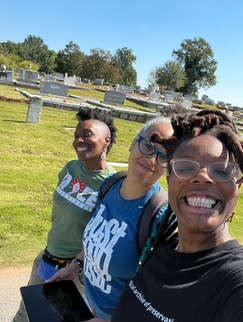ICHW Day GATHERING. South-View Cemetery and Luther Judson Price Home. 9.30.23
- shadyradical
- Oct 1, 2023
- 2 min read
This Saturday, my ICHW family gathered to tour South-View Cemetery and the Luther Judson Price Home in Atlanta. Organized by Robert Thompson of Insight Cultural Tourism, we learned about the history of the African American burial grounds directly from the current President, Winifred Watts Hemphill and the Luther Judson Price home from Mr. Thompson himself along with Stephanie Thioubou.
This gathering was sponsored by ICHW. "Idle Crimes & Heavy Work (ICHW) is a participatory community-oriented dance research endeavor exploring the history of Black women's incarcerated labor, resistance, and restoration in Georgia. Through archival and embodied memory research, interactive performance, workshops, dance films, and community gatherings, ICHW connects the stories of women past and present to sites throughout Atlanta that were shaped by their labor but long since forgotten" (taken directly from ICHW's website).
South-View Cemetery, 1990 Jonesboro Road SE Atlanta, Georgia 30315
Not only was Dr. King's original burial site at South-View, before it moved in 1970, but his parents and grandparents are buried there. Some other notables include: Charles Lincoln Harper, the 1st Principal of the 1st Black High School in Atlanta, Booker T. Washington High School;
William Henry Crogman, 1st Black president of Clark Atlanta University; Alonzo Herndon, Barber founder of the Crystal Palace and Atlanta Life Insurance; George Union Wilder, an Overseer of Chattahoochee Brick Company; Senator John Lewis; John Wesley Dobbs; and the Whitman Sisters, 4 African American sisters who were stars of Black Vaudeville and ran their own touring company TOBA from 1900-1943.
Luther Judson Price Home, 75 Gammon Street, Atlanta, Georgia, 30315
Luther Judson Price was formerly enslaved before graduating from Clark College and becoming a well-respected Post-master for the South Atlanta. The Hehn family purchased this home and restored it with the idea of contextualizing it in its rich history. As we sat in the gathering space, we talked about the stewardship of the family and the importance this kind of work plays in remembering our rich history. Decorating the walls was also quilts made by Robert Thompson's mother, Patricia Thompson. The beautiful pieces were so different and varied, that they told many rich stories just by looking at them. Julie Johnson mentioned there is a Gee's Bend exhibition coming to Spelman soon, which made me think about how the history of this space acted as framing devices for what we saw, how we communed, and ideas that came up there.
Here are some photos




























































Comments